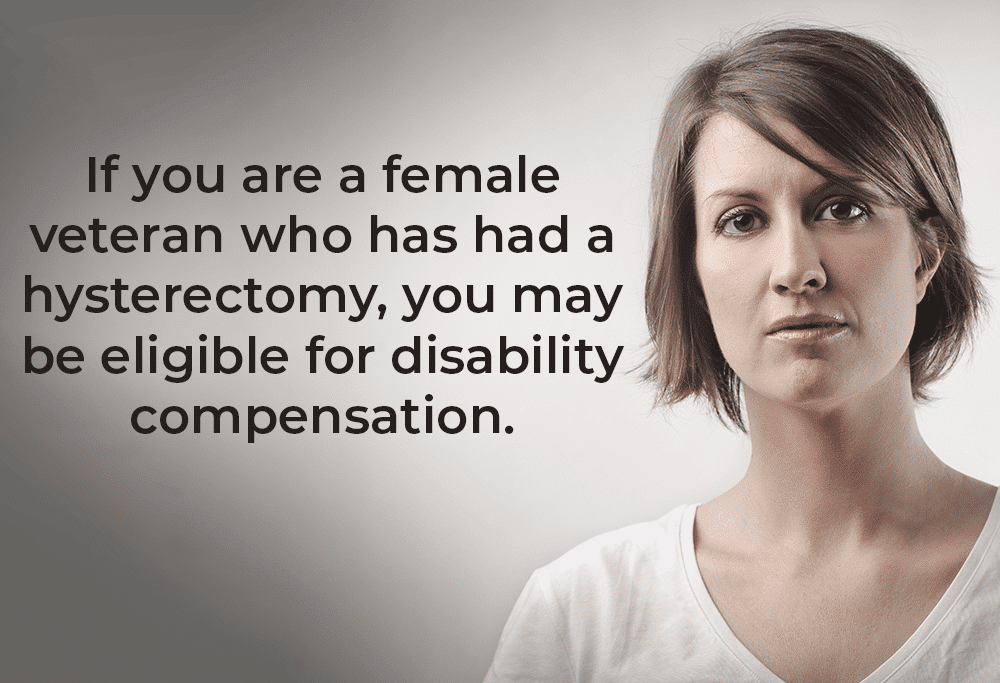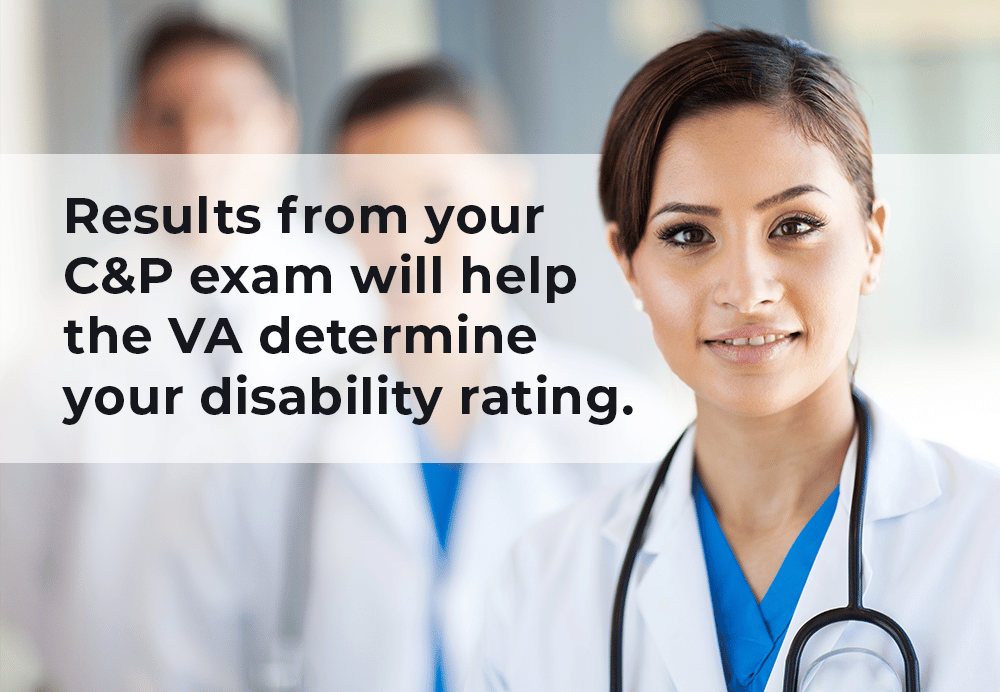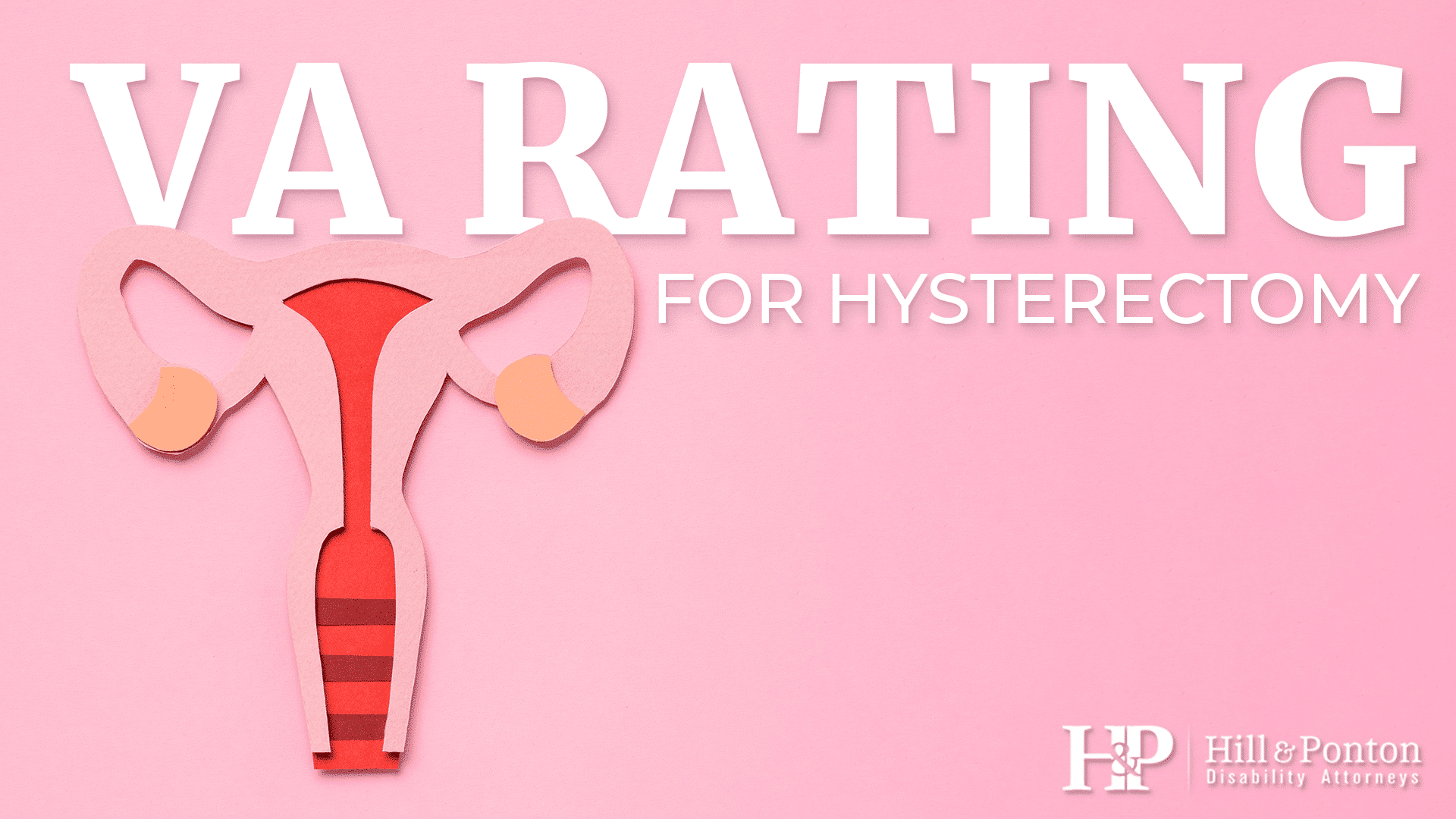If you are a female veteran who has had a hysterectomy to fully or partially remove your reproductive organs, you may be eligible for disability compensation if your symptoms developed during active duty. Hysterectomy is a surgical procedure that removes the uterus and potentially other parts of the reproductive organs as well. Your doctor might recommend that you undergo a hysterectomy for any of the following reasons:
- Abnormal periods
- Chronic pelvic pain
- Diagnosis or high risk of cervical, ovarian, or uterine cancer
- Endometriosis
- Fibroids
- Uterine prolapse
In the case of cancer, removal of your reproductive organs can extend your life by many years and allow you to avoid going through chemotherapy. During a total hysterectomy, the surgeon removes your cervix and uterus while keeping your fallopian tubes, ovaries, and vagina in place. A partial hysterectomy removes only the uterus while leaving the cervix and all other reproductive organs in place.
What Is the VA Rating for Hysterectomy?
The maximum hysterectomy VA rating of 100% is given for 3 months after the surgery while the veteran recovers. After that, the VA assigns a disability rating of 30% under diagnostic code 7619 – or a 50% rating under diagnostic code 7617 for the removal of the uterus and both ovaries.
Should you receive a disability rating above 30 percent, the VA will consider whether others in your family rely on your financial support. If so, you will receive special monthly compensation beyond what you qualify for with your disability rating.

VA Disability and Service Connection for Hysterectomy
The Department of Veterans Affairs (VA) requires that anyone applying for disability compensation meet the following three criteria:
- Formal diagnosis of the medical condition that required a hysterectomy to treat. You should ask your doctor to provide a letter stating the diagnosis and reason for surgery.
- Description of an in-service connection that caused your medical condition or made it worse. Your doctor can expand on the description of your gynecological conditions in the letter stating your diagnosis.
- A medical nexus that establishes a clear service connection between your gynecological conditions that necessitated hysterectomy. Proving a disability for hysterectomy can be more challenging than other types of disability claims. One obvious example would be a gunshot wound in the abdomen that damaged your uterus to the point a surgeon had to remove it to save your life. Even if you did not require an immediate hysterectomy but had to have one after leaving active duty from a medical condition related to scar tissue, you could still be eligible for veterans benefits. If your active duty service included exposure to Agent Orange or other toxic chemicals, you may have a service connection for hysterectomy since medical researchers have determined a positive link between toxic chemicals used in military service and several types of cancer.
It is normal to feel frustrated and overwhelmed at this point in the process of applying for disability compensation benefits. Please know that help is available through the law firm of Hill & Ponton. We have helped thousands of people apply for veterans claims and receive the compensation they deserve for their service to the United States.

Secondary Service Connection for Hysterectomy
A secondary service connection is any medical condition caused by the primary medical condition for which you receive disability compensation benefits. For example, perhaps you intended to try to get pregnant after leaving active duty military service but no longer can because a surgeon removed your reproductive organs during a hysterectomy. If you developed severe depression in response to the hysterectomy and can prove a service connection, you may be eligible for VA benefits for the second condition as well.
Compensation & Pension (C & P) Exams for Hysterectomy

The VA will require you to undergo a C & P exam as part of its disability evaluation if it requires more information to process your claim for veterans benefits. Results from your C & P exam will help the VA determine your disability rating. Here is what you can expect as a claimant undergoing a C & P exam:
- The doctor will review your veterans claim.
- The doctor will then ask you questions about the medical records in your claim file. Questions may come from the Disability Claims Questionnaire relating to each medical condition that you have claimed has a service connection. You may need to have additional tests performed if the doctor requests them. An exam related to VA disability for hysterectomy might include a pap smear, hysteroscopy, dilation and curettage, or another typical gynecological procedure. The purpose of these tests is to look for abnormalities such as cancer cells to support your claim for disability compensation benefits.
- After completing your C & P exam, the doctor forwards your updated medical records to the Department of Veterans Affairs for further review. You will not receive a copy of the doctor’s report unless you request it. The VA uses the report from your C & P exam along with your previous medical records, statements you and others have provided about your gynecological conditions and hysterectomy, medical records from the military, and personnel records from the military.
If you receive a favorable result from your C & P exam, the doctor will write a nexus letter to the VA outlining why your gynecological conditions and hysterectomy relate to your military service. You could also receive an unfavorable result, which means the doctor does not feel a service connection exists with your current medical condition. The doctor may have been missing important medical records to establish the service connection or may not be experienced enough with your specific gynecological conditions to rule favorably.
Whatever the reason for the unfavorable result, you have options to refute it. We recommend that you contact Hill & Ponton for legal representation so we can further advise you. Some veterans in this situation choose to undergo an independent medical examination (IME) from a different healthcare provider. Depending on your specific gynecological conditions, you may not need to appear in person for your IME if the second doctor can simply review your medical records.
Complete an Online VA Disability Claim Today
Hill & Ponton is available to help you through the appeals process if you are not satisfied with your disability compensation decision. We invite you to start by completing our online VA Case Evaluation that should only take a few minutes of your time. You may also contact us directly at 1-888-373-9436 with additional questions about disability ratings, establishing a service connection, or anything else related to the veterans claim process.




